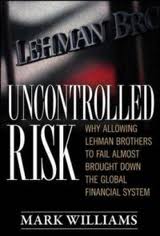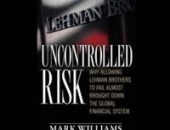Uncontrolled Risk: The Lessons of Lehman Brothers and How Systemic Risk Can Still Bring Down the World Financial System by Mark T. Williams 220 pp., not including 27 pp of Appendix, Notes, and Index
(Reprinted from The Analyst, March 2011 issue.)
On September 15, 2008, the 158-year-old investment bank, Lehman Brothers, filed for bankruptcy, thereby unleashing a horde of systemic risk effects that continue to bedevil the financial system. In this recently-published investigation into how the collapse of one iconic institution contaminated an entire sector, Mark T. Williams draws some sobering lessons.
In the 1990s, author Mark T. Williams worked for a trading firm that was previously affiliated with Lehman Brothers. At that time Lehman had a stellar reputation in risk management and in profit generation, so in 2008 when Lehman Brothers began to implode, Williams became obsessed with finding out why things went wrong.
Lehman’s humble beginnings
Lehman Brothers began as a humble dry goods store, founded in
Post-Civil War, Lehman moved headquarters to
LTCM meltdown—in fact, the showdown on Wall Street built the reputation of Richard Fuld, Lehman’s final Chairman and Chief Executive Officer.
 The reader cannot help but cheer for a company that conquered so many grave challenges. It made the eventual ruin that much more bitter.
The reader cannot help but cheer for a company that conquered so many grave challenges. It made the eventual ruin that much more bitter.
From the late 1990s onwards, Lehman became a mortgage origination machine to feed the demand from securitization activities. As its fame grew, it accepted lower credit standards, increased its leverage ratio, and augmented its mortgage derivatives. In late 2006 the first cracks started to appear in the largest mortgage-backed underwriter on Wall Street when default rates on mortgages started to escalate.
An arrogant approach to managing risk
What led to the downfall of Lehman? It turns out to be a story of hubris writ large. Top-level management boasted that Lehman was all about “demonstrating smart risk management” but later on refused to heed warnings from their own experts. As one example, Williams points to the troubling pattern of VaR. In 2002-3 the daily VaR exposure was $22 million. By 2007 this had ballooned nearly ten-fold. It was nearly equal to that of Goldman Sachs—yet Lehman put aside only half the capital. Nor did Lehman monitor other risks related to
liquidity, availability of funding, operational costs, and the likelihood of credit default.
In 2006, Lehman’s Chief Risk Officer, Madelyn Antoncic, received the coveted Risk Manager of the Year award from Risk Magazine but by 2007 was being asked to leave the room during risk management meetings. Soon replaced, Antoncic later stated that hedging of risk associated with residential mortgage-backed securities (RMBS) was frowned upon at Lehman because top executives thought it reduced profits too much.
The final hours
There is morbid fascination with the final hours of panic. Williams lays out the death march month by month (“Time Runs Out”) which shrinks to day by day (“The Death of Lehman,
Regulation, and Investment Banking”). When bankruptcy was inevitable, there was no orderly process, only a stampede by Lehman’s trading partners that further unleashed enormous systemic risk with trillions of dollars of market valuation vanishing. “The Lehman bankruptcy eventually helped push the Dow down by more than 4,000 points to below 6,700 in March 2009.”
Recommendations for controlling systemic risk
Williams provides a succinct primer on investment banking—from
The epilogue contains ten recommendations to control systemic risk:
- About 30 “too big to fail” banks should be mandated to hold more capital, rein in leverage, and exercise better oversight.
- Policies on moral hazard, compensation and executive accountability need re-working.
- Williams points to the Canadian system as a suitable model. See quotation below for his actual recommendation.
The appendices include a Lehman chronology (1845-2010), ten pages of notes, and an index. (The index is unfortunately incomplete; for example, “OSFI” is mentioned in Williams’ full
quotation given here but is not included in the index.)
A deeper look at the fall of an investment icon
You may have followed the Lehman collapse in the press, but this book, describing Lehman’s trajectory within the context of investment banking, and the speed of its fall, and its repercussions in the regulatory world, is well worth the read. ª
For more information on Williams’ motivation for writing this book, visit his web site, http://www.uncontrolledrisk.com/
Praise for Canadian banks
Williams’ full quote lauding risk management practices at Canadian banks is as follows:
“For proof that these prescriptions maintain healthy markets, one need only look northward. American banks were at the epicentre of the Great Credit Crisis of 2008
while Canadian banks walked away nearly unscathed.

